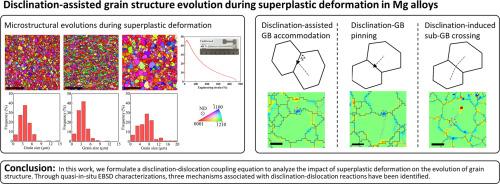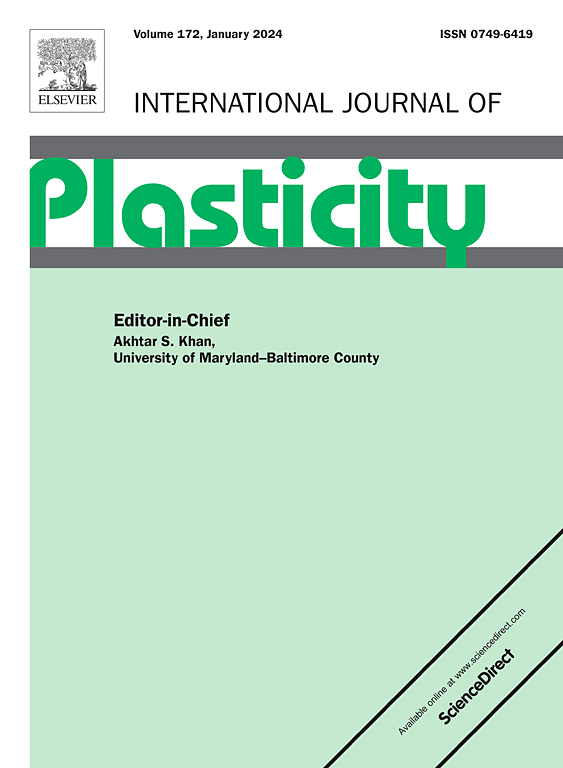The evolution of grain boundary structure mediated by disclinations in magnesium alloys under superplastic deformation
IF 9.4
1区 材料科学
Q1 ENGINEERING, MECHANICAL
引用次数: 0
Abstract
Superplastic deformation in metals and alloys, characterized by ultrahigh ductility (exceeding 300%) without cracking at elevated temperatures, is a critical process for manufacturing complex-shaped components. While a few grain-boundary (GB)-mediated deformation mechanisms have been identified as essential contributors to superplasticity in fine-grained polycrystals (grain size is typically less than 10 μm), it is still a challenge to maintain a steady fine-grained microstructure and sustainable plastic flow at high temperatures. Partially due to the lack of a quantitative description of dislocation-GB reactions, it has not been well recognized how grain coarsening can be suppressed by the external loading during superplastic deformation. In this work, we address this challenge by formulating a disclination-dislocation coupling equation within the Lie-algebra framework, providing a quantitative understanding of the interactions between disclinations, dislocations, and GBs. Using quasi-in-situ electron backscattered diffraction (EBSD) analysis in Mg alloys, we systematically investigate the multiscale interactions of the defects and their impact on grain structure evolution. Three key mechanisms that suppress conventional grain coarsening have been identified, i.e., disclination-assisted GB accommodation, disclination-GB pinning, and disclination-induced sub-GB crossing, all of which are captured by the proposed equation. This study contributes to the broader field of plasticity by linking macroscopic deformation behavior with microscopic mechanisms, offering new insights into the theory of superplastic deformation in metals and alloys.

超塑性变形下镁合金晶界结构的变化
金属和合金的超塑性变形具有超高延展性(超过 300%),在高温下不会产生裂纹,是制造复杂形状部件的关键工艺。虽然一些由晶界(GB)介导的变形机制已被确定为细粒多晶体(晶粒大小通常小于 10 μm)超塑性的基本促成因素,但要在高温下保持稳定的细粒微观结构和可持续的塑性流动仍是一项挑战。部分由于缺乏对位错-GB 反应的定量描述,人们还没有很好地认识到在超塑性变形过程中如何通过外部加载来抑制晶粒粗化。在这项工作中,我们通过在李代数框架内建立一个位错-位错耦合方程来应对这一挑战,从而提供了对位错、位错和 GB 之间相互作用的定量理解。通过对镁合金进行准原位电子反向散射衍射(EBSD)分析,我们系统地研究了缺陷的多尺度相互作用及其对晶粒结构演化的影响。我们发现了抑制常规晶粒粗化的三种关键机制,即:偏析辅助 GB 容纳、偏析-GB 针销和偏析诱导的亚 GB 交叉,所有这些机制都能被所提出的方程捕捉到。这项研究将宏观变形行为与微观机制联系起来,为金属和合金的超塑性变形理论提供了新的见解,从而为更广泛的塑性领域做出了贡献。
本文章由计算机程序翻译,如有差异,请以英文原文为准。
求助全文
约1分钟内获得全文
求助全文
来源期刊

International Journal of Plasticity
工程技术-材料科学:综合
CiteScore
15.30
自引率
26.50%
发文量
256
审稿时长
46 days
期刊介绍:
International Journal of Plasticity aims to present original research encompassing all facets of plastic deformation, damage, and fracture behavior in both isotropic and anisotropic solids. This includes exploring the thermodynamics of plasticity and fracture, continuum theory, and macroscopic as well as microscopic phenomena.
Topics of interest span the plastic behavior of single crystals and polycrystalline metals, ceramics, rocks, soils, composites, nanocrystalline and microelectronics materials, shape memory alloys, ferroelectric ceramics, thin films, and polymers. Additionally, the journal covers plasticity aspects of failure and fracture mechanics. Contributions involving significant experimental, numerical, or theoretical advancements that enhance the understanding of the plastic behavior of solids are particularly valued. Papers addressing the modeling of finite nonlinear elastic deformation, bearing similarities to the modeling of plastic deformation, are also welcomed.
 求助内容:
求助内容: 应助结果提醒方式:
应助结果提醒方式:


